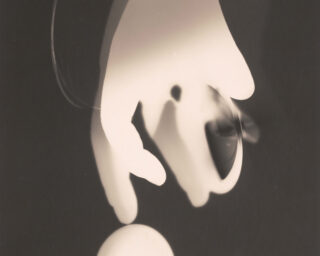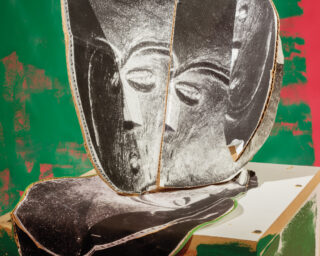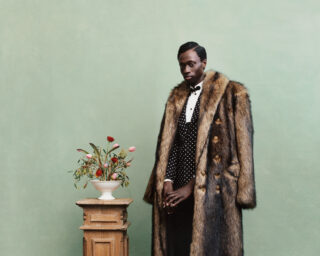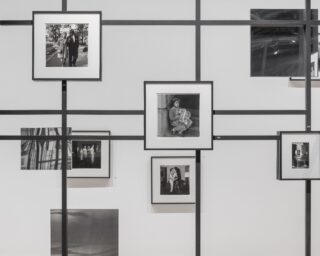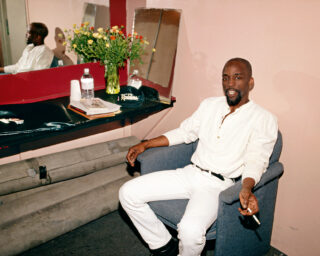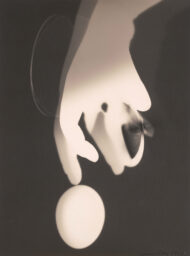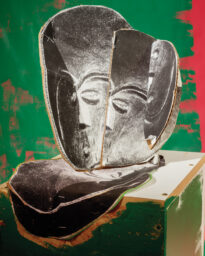David Galjaard: On Concresco
In 2008, David Galjaard began photographing the landscape of Albania, which is dotted with over 700,000 abandoned concrete bunkers built during the Communist dictatorship of Enver Hoxha. Galjaard’s work in Albania culminated in a self-published photobook, Concresco, which won the First PhotoBook Award in this year’s Paris Photo-Aperture Foundation PhotoBook Awards. Thomas Bollier spoke with the Dutch photographer about his work.
Thomas Bollier: Can you tell me a little about your history as a photographer – how and when you got started and what’s brought you to here?
David Galjaard: To go way back, it feels like I got started as a photographer when I was 15. My father gave me a copy of the book Amsterdam by Ed van der Elsken, and as soon as I saw that book I knew I wanted to be a photographer and that never changed. I studied at the Royal Academy of Art in The Hague, and while I was there I mainly worked the way van der Elsken did – with small film, really close to my subject, producing sort of emotional, social documentaries. As soon as I finished school, though, I found that that approach didn’t work for me anymore. I still love looking at those pictures but I wanted to do something else.
Around this time I got my own page in a national newspaper, called NRC Next, which had just started and hadn’t yet developed their visual vocabulary. They asked me if I wanted to work for them as a freelance photographer, and that’s where I feel my work as a photographer really began. We had an agreement that I would do a piece, and if they didn’t like it they would just tell me. But they never did. I could experiment while working, which was a big luxury. After three years at the paper, though, I felt the urge to work on a longer documentary project.
Around this time I also became interested in representing physical space in my photographs, exploring what environments without people can express. I had made a small series, When the siren goes, where I wanted to see if I could capture, in photographs, what I felt when I entered a space myself. I had explored Cold War bunkers in The Netherlands, in which I always felt a sort of ominous, uncanny feeling. I was wondering if it was possible to somehow capture that feeling…to take a photograph and show it to other people, and have them experience that place the same way. It was just a small experiment, and coming from the social documentary I was doing on the street, it was completely new to me.
One of the journalists from the newspaper saw my pictures from this series, and he asked me if I’d heard of the bunkers in Albania. I had traveled a lot through Eastern Europe, but never to Albania, and knew nothing of the history of the country. So I started reading about it, and bells started ringing when I read about the 750,000-1 million aboveground bunkers that were built in such a small country. I then traveled to Albania, just to look around. My first plan was to research how those bunkers have influenced the landscape and to see how, to the people who were still living there, those bunkers were still a reminder of a dictatorship that had lasted for almost fifty years. I traveled around Albania for a month, and took some good pictures, but it wasn’t much more than a small series, like something that would work in a magazine. I wanted to do more, but didn’t know what exactly. I kept reading and thinking about it, and after a couple of months realized that I wasn’t going to figure out what I wanted to do in Holland, so in October 2009 I traveled back to Albania. It was then that I decided that I should make a book.
TB: Albania, over the course of the past century, has been hindered by hardship and set-backs, and is still today finding its place in modern Europe. Were you daunted by the task of representing the complicated history and current problems of a country that is not your own?
DG: Yes, there were two big questions for me: can I use the bunkers as a visual metaphor in the telling of a larger social story? And, can I tell a story about a country that I don’t live in? I read a lot and spoke to a lot of people, and I tried to work as closely to facts as I could. But in the end every text, from The Pillbox Effect by Slavenka Drakulić, to the interviews, to my pictures, are all personal impressions. There are even texts in the book that are in contradiction. My mission was not to say, “This is truth. This is Albania.” It’s just an impression of a country, as close to a truth as possible, but perhaps just one of many truths. I hope I found a way to not approach the country in an arrogant way, coming in and telling everybody, “This is Albania,” because that is not what I intended to do.
TB:The texts in Concresco are important for contextualizing the photographs, and I found that reading the intermittent booklets of personal testimonials heightened my interest in the images–the more I read, the more I wanted to see. Was it always your intention to include texts in the book, or did you ever consider Concresco exclusively as a book of photographs? How important for you is the interaction of words and images?
DG: I read [Drakulić’s] essay The Pillbox Effect during my second trip to Albania, and that really helped me decide that this project had to become a book. I was working with all this information I had about the country, and I was trying to put as much information as possible into my pictures. But I knew even without seeing my pictures yet that they would not be enough to tell the whole story. I wanted to do the best I could, but at a certain point you hit a wall, and need something more to really explain the story. I make my images with a lot of information in them, but you also need other information to understand them.
On my second trip, I was approached by a Dutch documentary filmmaker who was making a movie about the bunkers and we made a deal that I could use the raw material of his interviews and I would show him all the locations he needed. So the interviews of the [older] Albanians came from him. I did the interviews with the younger people myself, because I wanted to know more about the present and future [of Albania], and I could speak English with those people. The older people, who built the bunkers, or were trained in them, were done by Sarah Haaij and Martijn Payens. You can find texts from my book in their film Mushrooms of Concrete, and they used one of my pictures for the film poster, and my designer did the design of the poster, so there were some other crossovers too.
I knew quite early in the process that I needed text, so I also wrote to Drakulić and asked if I could use this essay from her book, and she said yes. So there are two different kinds of text in the book, the two longer stories [from Drakulić and Jaap Scholten] and the short interviews with Albanian people.
Regarding the different sizes of paper, first it started off as a solution to a practical problem, because I wanted to use as little text as possible. I’m a photographer, so of course I want to tell as much as possible with images, and only use text when I must. In the end we only had short pieces of interviews, and it just didn’t work out in the design to put them on a big page. So, we put them on a smaller page, and it was at that moment that I found out that it was a really great way to play in the editing, and things got exciting from there. It turned out to be a great way to make new connetions between the images and the text, and it gave me a lot more room to play, and that felt amazing. It really added another dimension to the book.
TB: The Netherlands has a rich tradition of photography and photobook-making, and you mentioned Ed van der Elsken as an influence. Are there any other Dutch photographers, photobooks, or graphic designers that you look to for inspiration?
DG: When I started off with this book, I really knew very little about photobooks. I had a lot of photobooks, but I knew nothing about making them myself. I was never really planning to make a book but this series just wanted to, needed to be a book, so this was the first time that I really started thinking about the photobook as an object. It was my designer’s first photobook too…At first we looked a lot at other photobooks, but pretty early on we stopped looking at other work and really tried to design the book for the series, and the story we wanted to tell. There was one book that really helped me make some decisions, though, and that was Shelter by Henk Wildschut. If I had to point to one book that was an inspiration, it’s that one.
TB: You worked with designer Katie McGonigal to bring Concresco to life as a book. How did you come to work with her, and how did you two collaborate in the process of designing the book?
DG: Katie McGonigal is actually my girlfriend…I really like her work; she has a sort of analog way of working. If you work with her you wont sit behind a computer very much; it’s all tactile, and 3d, and cutting and pasting, so that’s one of the things I really liked because I do the same–I like the analog way of working and spending as little time as possible behind a computer.
The other point was that if there was no other solution, she was willing to work for free, so that of course also really helped me out. From the start we worked on this very much together, but I was more focused on the editing of the text and the images, and she was more into the design. But because we worked so close, all the time, and sometimes seven days a week, for weeks, we also influenced each other. She had influence on the editing, I had influence on the design. So there was a lot of symbiosis – with some ideas we don’t even recall whose idea it was because we were really working as one unit. You can imagine, if you wake up every morning next to your designer and the first thing you do is start talking about the book, and you do this for over a year, it all gets sort of blurry. It took us quite some time, a couple of months, to really find out which role we both were playing. But we eventually found the right balance.
TB: Is there any advice you’d offer to others interested in self-publishing their work?
DG: Don’t make a deadline. Never start with your deadline, because you’re probably not going to make it. Give yourself the time. Also, it’s very important to put your project away for a couple of months, if you can. When you’re working so intensely on a project, you will inevitably have tunnel vision, and to get out of the tunnel the best way is just to put it aside for a month, maybe two, and then look at it again.
Also, don’t make concessions. If you do a self-published book and it’s going to take all your time, and all your money, and all your energy anyway, why should you make a book with concessions? If, you’re lacking the money and you have to make sacrifices in the design, you’re not going to be satisfied. You just have to find a way to get that money.
To publish the book, [I raised] a lot of outside money; I had some funding from an art organization, and there were two companies that put some money into it, thanks to the Dutch embassy in Tirana in Albania. I won a pitch, I did crowdfunding and put all my own money into it, as well.
It was an intense, non-stop project. You’re the boss of everything, you know, but you feel that you don’t know anything. It was an amazing learning experience. I can’t recall since I first started photographing learning so much in such a short amount of time, and well, to say it in an American way, “It was a hell of a ride.”
Self-published / Den Haag, The Netherlands, 2012 / Designed by Katie McGonigal / 21.3 x 34 cm / 168 pages / 62 color photographs / Clothbound
David Galjaard graduated in 2006 from the art academy in The Hague, The Netherlands. Since then he has worked as a documentary photographer and as a freelancer for national newspapers and magazines. He has won several awards and has received grants to complete projects in The Netherlands, Albania, and Nigeria.
Thomas Bollier is a graduate of McGill University and the digital media work-scholar at the Aperture Foundation.











